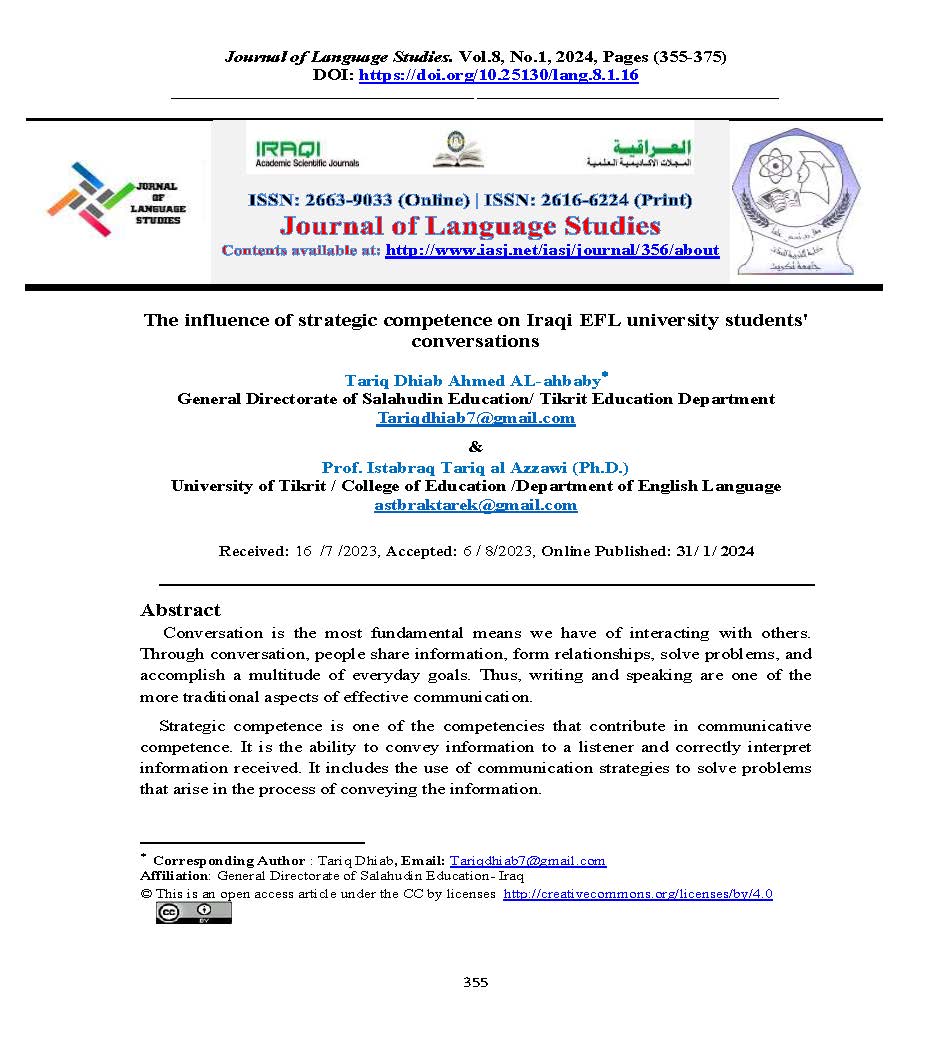The influence of strategic competence on Iraqi EFL university students' conversations
DOI:
https://doi.org/10.25130/lang.8.1.16Keywords:
Conversation and Strategic competenceAbstract
Conversation is the most fundamental means we have of interacting with others. Through conversation, people share information, form relationships, solve problems, and accomplish a multitude of everyday goals. Thus, writing and speaking are one of the more traditional aspects of effective communication.
Strategic competence is one of the competencies that contribute in communicative competence. It is the ability to convey information to a listener and correctly interpret information received. It includes the use of communication strategies to solve problems that arise in the process of conveying the information.
Thus, the current study aims to evaluate EFL students' conversational performance in accordance to competence in the written and spoken conversation. In order to accomplish these objectives, the following research questions are formulate: Is there statistical significance in strategic competence as a general dimension between university students' performances at Tikrit and Samarra universities? Is there statistical significance among Iraqi EFL university students' conversational performances in strategic competence at both spoken and written levels? To achieve these research questions, the following aims are posed: Identify and compare influences of strategic competence on Iraqi EFL university students' conversational performance between two universities (Tikrit and Samarra). Moreover, Identify and compare strategic competence levels in spoken and written acts between the two universities (Tikrit and Samarra).
Conversation is the most fundamental means we have of interacting with others. Through conversation, people share information, form relationships, solve problems, and accomplish a multitude of everyday goals. Thus, writing and speaking are one of the more traditional aspects of effective communication.
Strategic competence is one of the competencies that contribute in communicative competence. It is the ability to convey information to a listener and correctly interpret information received. It includes the use of communication strategies to solve problems that arise in the process of conveying the information.
Thus, the current study aims to evaluate EFL students' conversational performance in accordance to competence in the written and spoken conversation. In order to accomplish these objectives, the following research questions are formulate: Is there statistical significance in strategic competence as a general dimension between university students' performances at Tikrit and Samarra universities? Is there statistical significance among Iraqi EFL university students' conversational performances in strategic competence at both spoken and written levels? To achieve these research questions, the following aims are posed: Identify and compare influences of strategic competence on Iraqi EFL university students' conversational performance between two universities
References
Aljuboory, N. (2014). A Language Teacher's Guide to Assessment. London: Cambridge University Press.
Bell , R.T.( 1981 ). An introduction to applied linguistic : approaches and methods in language teaching . London : B.T. Bats ford .
Best , J.W. ( 1981 ) . Research in education (4th ed). New Jersey : Prentice – Hall, Inc.
Brennan, S. E. (2010). Conversation and dialogue. Reseacrh Gate,3.
Canale, M. and Swain, M. (1980). "Theoretical Bases of Communicative Approaches to Second Language Teaching and Testing." Applied Linguistics, Vo1(1).
Celce-Murcia M, Dörnyei Z, and Thurrell, S.(1995). A Pedagogical Framework for Communicative Competence: A Pedagogically Motivated Model with Content Specifications. Issues in Applied Linguistics Vol 6 (2).
Chomsky N.(1965) Aspects of the theory of syntax. Cambridge, M. A.MIT press.
Cohen, A. (1996). Developing the ability to perform speech acts. Studies in Second Language Acquisition, 18, -Crystal, D. and Davy, D.( 1975) Advanced Conversational English. Harlow: Longman
Fairlough, Norman. (2001) Language and power. London: Longman .
Glass, G. V., and Stanley, J. (1970) Statistical Methods in Education and Psychology. U. S. A: Prentice- Hall Inc.
Grice, Paul (1975) Logic and conversation. In Cole, P.; Morgan, J. (eds.). Syntax and semantics. 3: Speech acts. New York: Academic Press.
Gronland , N.E. ( 1981 ) Measurement and Education in Teaching . 4 th ed. New York : Macmillan publishing co. , Inc.
Harris, David, P. (1969) Teaching English as a Second Language. New York: MC Graw- Hall book com.
Herlambang, M, A. (2022) Strategic Competence of English Education Department Students in Propsol Seminar and Thesis Defence Examination. Thesis. Universitas Jambi.
Linden, W.J. V. and Glas, C.A.W (2010) Statistics for Social and Behavioral Sciences Elements of Adaptive Testing. New York: Springer Science - Business Media, LLC.
Mazeland, H. (2006) Conversation analysis. Encyclopedia of language and linguistics, 3, 153-162.
Olshtain, E. & Cohen, A. (1991) Teaching speech act behavior to non- native speakers. In Celce-Murcia, M. (Ed.),Teaching English as a second or foreign language (2nd ed.). Boston: Heinle and Heinle.
Ramelan, M, A.(1991) Introduction to Linguistics Analysis. Semarang: IKIP Semarang Press
Richards , J.C. Platt, J. and Platt , H. (1992) Dictionary of Language Teaching and Applied Linguistics. London ; Longman.
Richards, J. and Schmidt, R. ( 2002) Dictionary of Language Teaching and Applied Linguistics. (3rd edition.) Harlow: Longman.
Weir, Cyril J. (2005) Language Testing and Validation. London: Palgrave Macmillan Hampshire.

